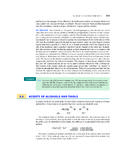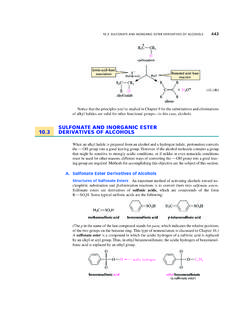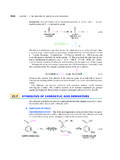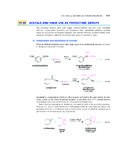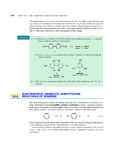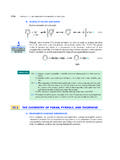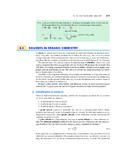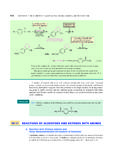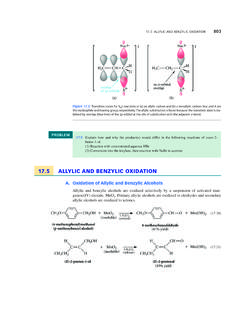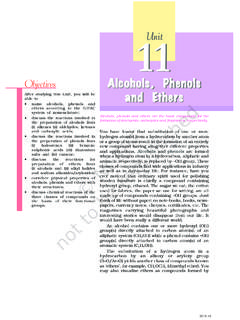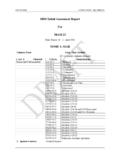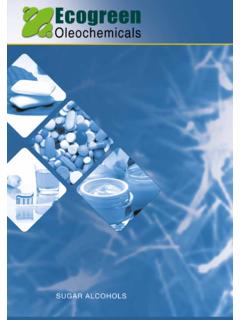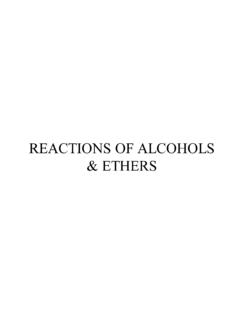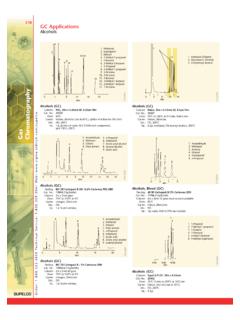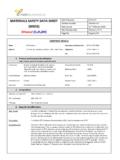Transcription of 10.2 REACTIONS OF ALCOHOLS WITH HYDROGEN …
1 440 CHAPTER 10 THE CHEMISTRY OF ALCOHOLS AND What alkene(s) are formed in the acid-catalyzed dehydration of each of the followingalcohols?(a)3-methyl-3-heptanol (b) Give the curved-arrow mechanism for the reaction in Problem In each step, identify allBr nsted acids and bases, all electrophiles and nucleophiles, and all leaving the structure of the carbocation intermediate involved in the acid-catalyzed dehydrationof the majoralkene product(s) in part (a) of Problem Give the structures of two ALCOHOLS , one secondary and one tertiary, that could give each ofthe following alkenes as a major acid-catalyzed dehydration product. In each case, which al-cohol would dehydrate most rapidly?(a)1-methylcyclohexene (b) (a) Give a curved-arrow mechanism for the reaction in Eq. (b) After reading Study Guide Link , explain why the rearrangement in Eq. is fa-vorable even though both of the carbocation intermediates involved are certain reaction is carried out in methanol with H2SO4as a catalyst.
2 (a) What Br nsted acid is present in highest concentration in such a solution? (Hint: H2SO4is completely dissociated in methanol, just as it is in water.)(b) If a base is involved in the reaction mechanism, what is the basic species? OF ALCOHOLS WITH HYDROGEN HALIDESA lcohols react with HYDROGEN halides to give alkyl halides:( )( )The equilibrium constant for the formation of alkyl halides from ALCOHOLS is not large;hence, the successful preparation of alkyl halides from ALCOHOLS , like the dehydration ofalcohols to alkenes, usually depends on the application of Le Ch telier s principle (Sec. ).For example, in both Eqs. and , the reactant ALCOHOLS are soluble in the reaction sol-vent, which is an aqueous acid, but the product alkyl halides are not. Separation of the alkylhalide products from the reaction mixture as water-insoluble layers drives both REACTIONS tocompletion. For ALCOHOLS that are not water-soluble, a large excess of gaseous HBr can be usedto drive the reaction to mechanism of alkyl halide formation depends on the type of alcohol used as the start-ing material.
3 In the REACTIONS of tertiary ALCOHOLS , protonation of the alcohol oxygen is fol-lowed by carbocation formation. The carbocation reacts with the halide ion, which is formedby ionization of strong acid HCl, and which is present in great excess:HCl+(CH3)3 COHL tert-butyl alcohol(CH3)3 CClLtert-butyl chloride(almost quantitative)H2O+25 C, 20 minH2O(CH3)2 CHCH2CH2 OHL3-methyl-1-butanolHBr+(CH3)2 CHCH2CH2 BrL1-bromo-3-methylbutane(93% yield)H2O+H2SO4heat, 5 6 hPhCHCH2 PhOH" 12/5/08 1:34 PM Page REACTIONS OF ALCOHOLS WITH HYDROGEN HALIDES441( )Once the alcohol is protonated, the reaction is an SN1reaction with H2O as the leaving group. When a primary alcohol is the starting material, the reaction occurs as a concerted displace-ment of water from the protonated alcohol by halide ion. In other words, the reaction is an SN2reaction in which water is the leaving group.( )( )Notice that the initial step in both of these SN1 and SN2 mechanisms is protonation of theLOH group.
4 As the conditions of Eqs. and suggest, the REACTIONS of tertiary ALCOHOLS with hy-drogen halides are much faster than the REACTIONS of primary ALCOHOLS . Typically, tertiary alco-hols react with HYDROGEN halides rapidly at room temperature, whereas the REACTIONS of pri-mary ALCOHOLS require heating for several hours. The REACTIONS of primary ALCOHOLS with HBrand HI are satisfactory, but their REACTIONS with HCl are very slow. Although REACTIONS of alco-hols with HCl can be accelerated with certain catalysts, other methods for preparing primaryalkyl chlorides (discussed in the following section) are REACTIONS of secondary ALCOHOLS with HYDROGEN halides tend to occur by the SN1 mech-anism. This means that carbocations are involved as reactive intermediates, and, consequently,rearrangements can occur in many Suggest an alcohol starting material and the conditions for the preparation of each of the fol-lowing alkyl halides.(a)(b) (c)ILCH2CH2CH2CH2CH2LI`Cl)$CH3CH3 CHCH2CH3Br( )HBr2-methyl-3-pentanolLLH3 CCHCH3""CHCH2CH3 LOH"2-bromo-2-methylpentaneLLH3 CCBrCH3""CH2CH2CH3L+H2 OOH2|L1(CH3)2 CHCH2CH2SN2 reaction+(CH3)2 CHCH2CH2H2OL33111Br_3311 BrH+(CH3)2 CHCH2CH2 OHLL11311Br+(CH3)2 CHCH2CH2OH2|L1_3311Br(excess)( )( )+(CH3)3C|H2O31Cl311(CH3)3 CLCl_3311+(CH3)3C|SN1 reaction(CH3)3CO|HLL1H"HCl++(CH3)3 COHLL311Cl_331111(CH3)3CO|HLL1H"(excess) 12/5/08 1:34 PM Page 441442 CHAPTER 10 THE CHEMISTRY OF ALCOHOLS AND a curved-arrow mechanism for the rearrangement shown in Eq.
5 Give the structure of the alkyl halide product expected (if any) in each of the followingreactions.(a)1-propanol +HBr in the presence of H2SO4catalyst(b) (c)(d) (Hint:See Fig. , p. 392.)The dehydration of ALCOHOLS to alkenes and the REACTIONS of ALCOHOLS with HYDROGEN halideshave some important things in common. Both take place in very acidic solution; in both reac-tions, the acid converts the LOH group into a good leaving group. We ve already discussedthis point for dehydrations in Sec. For substitution REACTIONS , if acid were not present, thehalide ion would have to displace _OH to form the alkyl halide. This reaction does not takeplace because _OH is a much stronger base than any halide ion (Table , p. 103), and strongbases are poor leaving groups (Sec. ).Remember: substitution and elimination REACTIONS of ALCOHOLS require theLOH group to beconverted into a better leaving group. The formation of secondary and tertiary alkyl halides and the dehydration of secondary andtertiary ALCOHOLS have the same initial steps: protonation of the alcohol oxygen and formationof a two REACTIONS differ in the fate of this carbocation, which in turn is governed by the con-ditions of the reaction.
6 In the presence of a HYDROGEN halide, the halide ion is present in excessand reacts with the carbocation. In dehydration, no halide ion is present, and when the alkeneforms by loss of a b-proton from the carbocation, the conditions of the dehydration reactionforce the removal of the alkene product and the water by-product from the reaction mixture. Itfollows, then, that alkyl halide formation and dehydration to alkenes are alternative branchesof a common mechanism:( )23|+H2OH"13CR2 HXR2CH+OHLCR2R2CL""protonationof the OH formation ofa carbocation X_|3 HOH2 LCR2R2 CLL""( )+|OHHLL1CH3L311Br3H2O1weak base(good leaving group)"+H3C_3311Br( )++H3 COHL11CH3L311Br_3311 Brweak base_3OH11strong base(poor leaving group)HCl+25 C(CH3)3 CCH2 OHexcess HBr+heatCHCH3 LLOH"(CH3)3 Cexcess HIHOCH2CH2CH2OH+ 12/5/08 1:34 PM Page SULFONATE AND INORGANIC ESTER DERIVATIVES OF ALCOHOLS443 Notice that the principles you ve studied in Chapter 9 for the substitutions and eliminationsof alkyl halides are valid for other functional groups in this case, AND INORGANIC ESTERDERIVATIVES OF ALCOHOLSWhen an alkyl halide is prepared from an alcohol and a HYDROGEN halide, protonation convertsthe LOH group into a good leaving group.
7 However, if the alcohol molecule contains a groupthat might be sensitive to strongly acidic conditions, or if milder or even nonacidic conditionsmust be used for other reasons, different ways of converting the LOH group into a good leav-ing group are required. Methods for accomplishing this objective are the subject of this Sulfonate Ester Derivatives of AlcoholsStructures of Sulfonate EstersAn important method of activating ALCOHOLS toward nu-cleophilic substitution and b-elimination REACTIONS is to convert them into sulfonate esters are derivatives of sulfonic acids,which are compounds of the formRLSO3H. Some typical sulfonic acids are the following:(The pin the name of the last compound stands for para, which indicates the relative positionsof the two groups on the benzene ring. This type of nomenclature is discussed in Chapter 16.)A sulfonate esteris a compound in which the acidic HYDROGEN of a sulfonic acid is replacedby an alkyl or aryl group.
8 Thus, in ethyl benzenesulfonate, the acidic HYDROGEN of benzenesul-fonic acid is replaced by an ethyl acidLL LSOHOOcSSethyl benzenesulfonate(a sulfonate ester)LL LSOC2H5 OOcSSacidic hydrogenLH3 CSO3 Hmethanesulfonic acidLLSO3HH3 Ccp-toluenesulfonic acidLSO3 Hcbenzenesulfonic acid( )"|H+"X"$$$$CCH2OH3 OAalkyl halidealkeneX_(halide ion)carbocation|HCR2R2 CLLCR2R2 CLRRRRBr nsted acid basereactionLewis acid 12/5/08 1:34 PM Page 443
